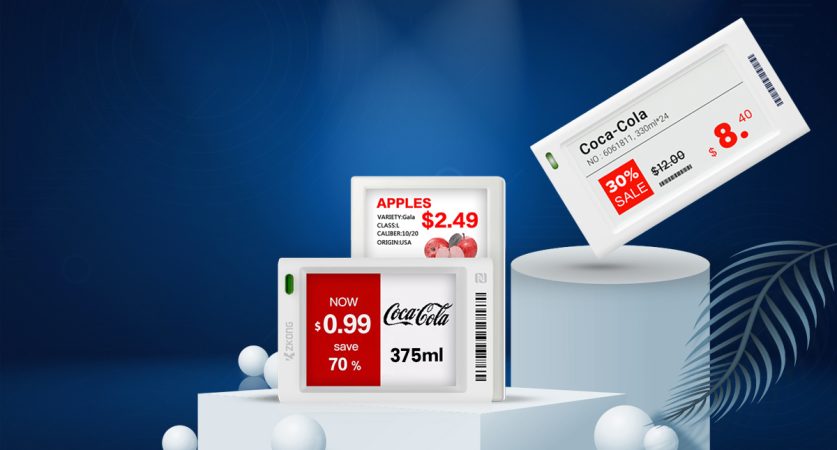Revolutionizing Retail: The Impact of Electronic Shelf Labeling on Customer Experience

In the fast-paced world of retail, staying ahead of the competition is crucial. One technology that has been making waves in the industry is Electronic Shelf Labeling (ESL). As the retail landscape continues to evolve, ESL is emerging as a game-changer, offering unprecedented advantages in terms of efficiency, accuracy, and customer engagement. In this article, we will delve into the world of ESL, exploring its benefits, implementation, and the transformative impact it has on the overall retail experience.
Understanding Electronic Shelf Labeling:
Shelf Labels: The Foundation of ESL
Before delving into the intricacies of Electronic Shelf Labels, it’s essential to understand the significance of shelf labels in the retail environment. Shelf labels serve as the backbone of any retail operation, providing vital information about products, prices, and promotions. Traditionally, these labels were paper-based and manually updated, leading to potential errors, delays, and increased operational costs.
Electronic Shelf Labeling (ESL) steps in as a modern solution to address these challenges. ESL replaces traditional paper labels with digital displays that can be remotely controlled and updated in real-time. These digital labels not only enhance the visual appeal of the store but also streamline various retail processes.
Benefits of Electronic Shelf Labeling:
Real-time Price Updates:
One of the primary advantages of ESL is the ability to update prices in real-time. This feature ensures that customers always see accurate and up-to-date pricing information, reducing the likelihood of pricing errors and disputes. Retailers can swiftly respond to market fluctuations, implement promotional pricing, and adjust prices dynamically, enhancing overall pricing strategy.
Efficient Inventory Management:
ESL systems are integrated with inventory management systems, providing retailers with real-time insights into stock levels. With accurate inventory data, retailers can optimize stock levels, reduce overstock or stockouts, and enhance overall supply chain efficiency. This leads to improved customer satisfaction by ensuring that products are consistently available on the shelves.
Enhanced Customer Experience:
The interactive nature of ESL contributes significantly to an enriched customer experience. Digital displays can showcase product information, reviews, and even complementary items, aiding customers in making informed purchasing decisions. Additionally, ESL allows for easy implementation of loyalty programs, promotions, and personalized discounts, fostering customer engagement and loyalty.
Reduced Operational Costs:
While the initial investment in ESL technology might seem significant, the long-term benefits include substantial cost savings. Automation of pricing updates and inventory management reduces the need for manual labor, minimizing errors and operational inefficiencies. Over time, this results in a more streamlined and cost-effective retail operation.
Implementation of Electronic Shelf Labeling:
Integration with Existing Systems:
Before implementing ESL, retailers need to ensure seamless integration with their existing systems. This includes POS (Point of Sale) systems, inventory management software, and other relevant databases. A well-integrated ESL system ensures that information flows seamlessly across all touchpoints, providing a cohesive and synchronized retail environment.
Training and Change Management:
Transitioning from traditional paper labels to ESL requires training for store staff and management. Adequate training ensures that employees are proficient in utilizing the new technology and can troubleshoot common issues. Additionally, effective change management strategies help employees embrace the shift towards ESL, minimizing resistance and optimizing the implementation process.
Scalability and Future-Proofing:
When selecting an ESL solution, retailers should consider its scalability and compatibility with future advancements. A robust ESL system should be able to accommodate the evolving needs of the retail environment, including integration with emerging technologies such as IoT (Internet of Things) and AI (Artificial Intelligence).
The Future of Retail with Electronic Shelf Labeling:
As technology continues to advance, ESL is poised to play an even more significant role in the future of retail. Here are some trends and developments that showcase the potential of Electronic Shelf Labeling:
IoT Integration:
The integration of ESL with IoT devices opens up new possibilities for data collection and analysis. Retailers can gather valuable insights into customer behavior, preferences, and in-store traffic patterns. This data-driven approach enables retailers to optimize store layouts, enhance product placement, and tailor marketing strategies for maximum impact.
Personalized Shopping Experience:
ESL technology allows retailers to create a personalized shopping experience for customers. Through the use of customer data and AI algorithms, ESL displays can showcase personalized product recommendations, promotions, and discounts. This level of personalization not only improves customer satisfaction but also increases the likelihood of repeat business.
Contactless Shopping:
In a post-pandemic world, contactless shopping experiences are gaining traction. ESL, when combined with mobile applications and payment systems, enables customers to browse, select, and purchase products without physical contact with items or checkout counters. This not only aligns with health and safety concerns but also provides a convenient and efficient shopping experience.
Conclusion:
In conclusion, Electronic Shelf Labeling is a transformative technology that is reshaping the retail landscape. From real-time price updates to enhanced customer experiences, ESL offers a myriad of benefits that position retailers for success in the competitive market. As technology continues to evolve, the integration of ESL with other emerging technologies will further amplify its impact, ushering in a new era of efficiency, accuracy, and customer engagement in the retail sector. Embracing Electronic Shelf Labeling is not just an investment in technology; it’s an investment in the future of retail.

Ashmawi Sami has a Bachelor degree in Travel and Tourism Management from the University of Minnesota. He has his own travel vlogging channel. Besides being a fantastic yoga instructor he has travelled to 9 countries and planning his next trip soon. As the father of 3 dogs, he is well-trained in parenting, crowd control, and crisis situations.
ABOUT ME

Gillian is a freelance blogger, student, and full-time traveler. Each day she spends her time exploring something exciting to help people find the information they need while travelling to a new destination. Whether it be the place to enjoy holidays, or a spot to throw a party or hidden gems that you must visit in the city.
ALL CATEGORIES
- Adventure (13)
- Automotive (8)
- blog (7)
- Business (682)
- Education (13)
- Event (4)
- Health (285)
- Insurance (11)
- KOKITOTO (1)
- Lifestyle (13)
- News (1)
- Real Estate (21)
- Shopping (27)
- Technology (24)
- Travel (7)
POPULAR POST
January 27, 2021 -
Adventure Travel For The Audacious Spirit
January 27, 2021 -
Small Business Loans for Women
January 27, 2021 -
Adventure Tours in Vanuatu
RECENT POST
November 23, 2024 -
Guide To Carbon Steel Pipe Fittings in Industrial Use
Carbon steel pipe fittings are extremely useful in...
November 23, 2024 -
What Are the Advantages of Turning Off Private Browsing? How to Turn Off Private Browsing
Private browsing, also known as incognito mode, is...
November 20, 2024 -
Website Gestalten und Websites Designen: Der Schlüssel zu Ihrer Online-Präsenz
In einer zunehmend digitalisierten Welt ist eine beeindruckende...
November 20, 2024 -
Maximizing Success in Real Estate with the Best Software and Lead Generation Strategies
In today’s competitive real estate market, success hinges...





















